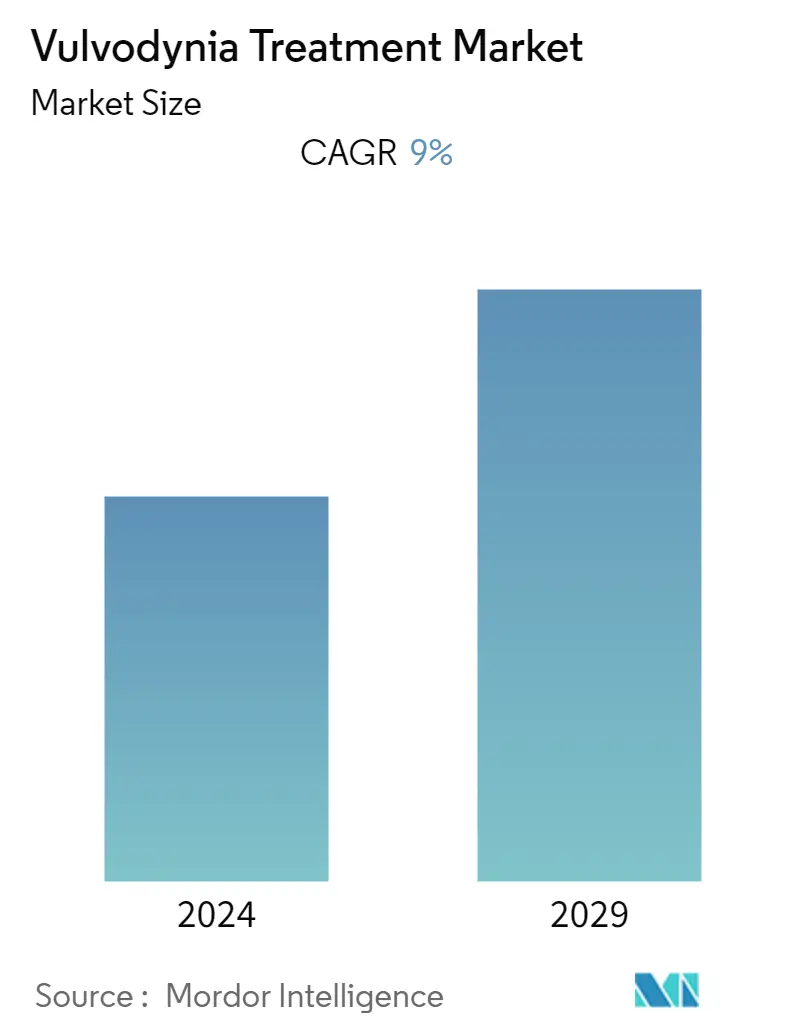Market Size of Vulvodynia Treatment Industry

| Study Period | 2019 - 2029 |
| Base Year For Estimation | 2023 |
| CAGR | 9.00 % |
| Fastest Growing Market | Asia-Pacific |
| Largest Market | North America |
| Market Concentration | Medium |
Major Players
*Disclaimer: Major Players sorted in no particular order |
Need a report that reflects how COVID-19 has impacted this market and its growth?
Vulvodynia Treatment Market Analysis
The vulvodynia treatment market is expected to register a CAGR of nearly 9% over the forecast period.
The COVID-19 pandemic significantly impacted the vulvodynia treatment market. As per an article published in February 2022 by Elsevier Public Health Emergency Collection, the COVID-19 pandemic posed significant obstacles to clinical practice, delaying the management of patients with curable conditions, including urogynecological conditions. Such studies indicate that the number of visits for vulvodynia treatment was reduced during the pandemic, thereby depicting a short-term negative impact on the market. However, with the introduction of vaccines and the upliftment of lockdown restrictions, the market is expected to show healthy growth in the coming period.
The market's growth is attributed to the factors such as increasing prevalence pertaining to vulvodynia and new emerging treatments for vulvodynia. For instance, as per an article in June 2021 published by Frontiers Media SA, the prevalence of localized provoked vulvodynia varies between 8-18% in the population. Localized provoked vulvodynia is a poorly recognized condition. 50% of symptomatic women sought care, 30% had three or more physician visits, and 40% remained undiagnosed. Additionally, according to an article published by Sexual Medicine in August 2021, itraconazole therapy is associated with a significant reduction in vulvovaginal pain in patients with negative fungus cultures. Also, according to an article published by National Vestibulodynia Association, in August 2022, Meclon Lenex vulvar emulgel revealed excellent tolerability and compliance, demonstrating to be a safe and effective option in the treatment of provoked vestibulodynia. Thus, new emerging treatments for vulvodynia are expected to drive the growth of the market over the forecast period.
The companies are actively involved in new product launches and approval, developments, and collaborations to expand their footprint. For instance, in April 2022, the US Food and Drug Administration (FDA) approved Mycovia Pharmaceuticals' VIVJOATM (oteseconazole), the first and only treatment for recurrent vaginal candidiasis. Such developments are expected to drive the growth of the market over the forecast period.
The above-mentioned factors are expected to drive the market's growth across the world. However, low awareness pertaining to vulvodynia and the lack of approved products are the major factors hindering the market's growth.
Vulvodynia Treatment Industry Segmentation
As per the scope of this report, vulvodynia, or pain in the vulva, is a chronic condition characterized by burning, stinging, and stabbing sensations. The treatment for vulvodynia includes avoiding irritants such as tight-fitting clothing, perfumes, and dyes, as well as medications such as local anesthetic and nerve medication, among other medications. The Vulvodynia Treatment Market is Segmented by Drug Type (Local Anesthetics, Anticonvulsants, Tricyclic Antidepressants, Antimicrobials, and Other Drug Types), Mode of Administration (Oral, Topical, and Injectable), Distribution Channel (Hospital Pharmacies, Retail Pharmacies, and Other Distribution Channels), and Geography (North America, Europe, Asia-Pacific, Middle-East and Africa, and South America). The market report also covers the estimated market sizes and trends for 17 different countries across major regions globally. The report offers the value (in USD million) for the above-mentioned segments.
| By Drug Type | |
| Local Anesthetics | |
| Anticonvulsants | |
| Tricyclic Antidepressants | |
| Antimicrobials | |
| Other Drug Types |
| By Mode of Administration | |
| Oral | |
| Topical | |
| Injectable |
| By Distribution Channel | |
| Hospital Pharmacies | |
| Retail Pharmacies | |
| Other Distribution Channels |
| Geography | ||||||||
| ||||||||
| ||||||||
| ||||||||
| ||||||||
|
Vulvodynia Treatment Market Size Summary
The vulvodynia treatment market is poised for substantial growth, driven by an increasing prevalence of the condition and the development of new treatment options. The market experienced a temporary setback due to the COVID-19 pandemic, which hindered patient visits and delayed treatment for urogynecological conditions. However, with the easing of restrictions and the introduction of vaccines, the market is expected to recover and expand. The emergence of innovative treatments, such as itraconazole therapy and Meclon Lenex vulvar emulgel, is anticipated to further propel market growth. Despite challenges like low awareness and a scarcity of approved products, the market is witnessing active participation from companies through product launches, approvals, and strategic collaborations.
Local anesthetics are expected to capture a significant portion of the market share, attributed to their safety and efficacy in treating vulvodynia. The segment's growth is supported by positive outcomes from therapy with local anesthetics, which have shown promising results in reducing vulvodynia symptoms. North America is projected to hold a substantial share of the market, driven by a rising incidence of vulvodynia, increased awareness, and robust healthcare infrastructure. The United States, in particular, is experiencing a growing demand for vulvodynia treatment, contributing to the market's expansion. The competitive landscape is characterized by the presence of both international and regional companies, with key players actively engaging in clinical developments and strategic initiatives to enhance their market position.
Vulvodynia Treatment Market Size - Table of Contents
-
1. MARKET DYNAMICS
-
1.1 Market Overview
-
1.2 Market Drivers
-
1.2.1 Increasing Prevalence Pertaining to Vulvodynia
-
1.2.2 New Emerging Treatments for Vulvodynia
-
-
1.3 Market Restraints
-
1.3.1 Low Awareness Pertaining to Vulvodynia
-
-
1.4 Porter's Five Forces Analysis
-
1.4.1 Threat of New Entrants
-
1.4.2 Bargaining Power of Buyers/Consumers
-
1.4.3 Bargaining Power of Suppliers
-
1.4.4 Threat of Substitute Products
-
1.4.5 Intensity of Competitive Rivalry
-
-
-
2. MARKET SEGMENTATION (Market Size by Value - USD million)
-
2.1 By Drug Type
-
2.1.1 Local Anesthetics
-
2.1.2 Anticonvulsants
-
2.1.3 Tricyclic Antidepressants
-
2.1.4 Antimicrobials
-
2.1.5 Other Drug Types
-
-
2.2 By Mode of Administration
-
2.2.1 Oral
-
2.2.2 Topical
-
2.2.3 Injectable
-
-
2.3 By Distribution Channel
-
2.3.1 Hospital Pharmacies
-
2.3.2 Retail Pharmacies
-
2.3.3 Other Distribution Channels
-
-
2.4 Geography
-
2.4.1 North America
-
2.4.1.1 United States
-
2.4.1.2 Canada
-
2.4.1.3 Mexico
-
-
2.4.2 Europe
-
2.4.2.1 Germany
-
2.4.2.2 United Kingdom
-
2.4.2.3 France
-
2.4.2.4 Italy
-
2.4.2.5 Spain
-
2.4.2.6 Rest of Europe
-
-
2.4.3 Asia-Pacific
-
2.4.3.1 China
-
2.4.3.2 Japan
-
2.4.3.3 India
-
2.4.3.4 Australia
-
2.4.3.5 South Korea
-
2.4.3.6 Rest of Asia-Pacific
-
-
2.4.4 Middle-East and Africa
-
2.4.4.1 GCC
-
2.4.4.2 South Africa
-
2.4.4.3 Rest of Middle-East and Africa
-
-
2.4.5 South America
-
2.4.5.1 Brazil
-
2.4.5.2 Argentina
-
2.4.5.3 Rest of South America
-
-
-
Vulvodynia Treatment Market Size FAQs
What is the current Vulvodynia Treatment Market size?
The Vulvodynia Treatment Market is projected to register a CAGR of 9% during the forecast period (2024-2029)
Who are the key players in Vulvodynia Treatment Market?
Upsher-Smith Laboratories, Viatris Inc., Cadila Pharmaceuticals, Bayer AG and Stada Arzneimittel AG are the major companies operating in the Vulvodynia Treatment Market.

